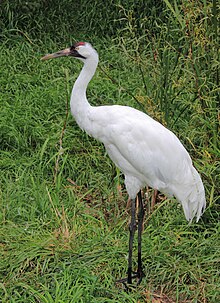| Whooping crane | |
|---|---|

| |
| In the Calgary Zoo, Alberta | |
| Scientific classification | |
| Domain: | Eukaryota |
| Kingdom: | Animalia |
| Phylum: | Chordata |
| Class: | Aves |
| Order: | Gruiformes |
| Family: | Gruidae |
| Genus: | Grus |
| Species: | G. americana
|
| Binomial name | |
| Grus americana | |

| |
| Distribution map of the whooping crane. blue: breeding, orange: wintering, green: year-round, grey: experimental year-round | |
| Synonyms | |
|
Ardea americana Linnaeus, 1758 | |
The whooping crane (Grus americana) is an endangered crane species, native to North America,[3][1] named for its “whooping” calls. Along with the sandhill crane (Antigone canadensis), it is one of only two crane species native to North America, and it is also the tallest North American bird species.[3] The whooping crane's lifespan is estimated to be 22-24 years in the wild.[3] After being pushed to the brink of extinction, due to unregulated hunting and loss of habitat, and just 21 wild (and two captive) cranes remaining by 1941, conservation efforts would lead to a partial recovery.[4][5] The total number of cranes in the surviving migratory population, plus three reintroduced flocks and in-captivity, only slightly exceeds 800 birds as of 2020[update].
- ^ a b BirdLife International (2020). "Grus americana". IUCN Red List of Threatened Species. 2020: e.T22692156A181242855. doi:10.2305/IUCN.UK.2020-3.RLTS.T22692156A181242855.en. Retrieved 13 November 2021.
- ^ "Appendices | CITES". cites.org. Retrieved 2022-01-14.
- ^ a b c "Whooping Crane (Grus americana)". tpwd.texas.gov. Retrieved 27 September 2023.
- ^ "Whooping Crane, Grus americana". U.S. Fish & Wildlife Service. Retrieved 30 April 2022.
- ^ Martin, Laura J. (2022). Wild by Design: The Rise of Ecological Restoration. Cambridge, Massachusetts: Harvard University Press. ISBN 978-0-674-97942-0.
